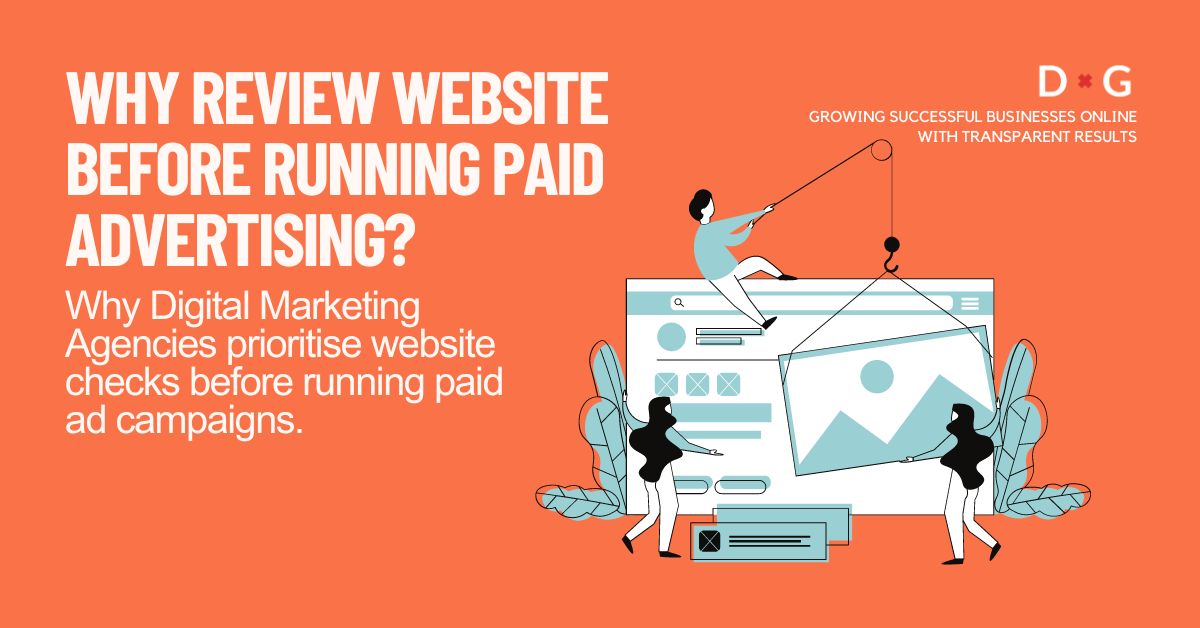
Launching paid ads can be an exciting step for growing your business. However, a thorough website review before running paid advertising is important to ensure everything is in place for the best possible results.
This blog will guide you through the reasons, steps, and benefits of prepping your website before spending a dime on paid advertising.
Why checking your website before starting ad campaigns is important?
Let’s break it down in simple terms.
First Impressions Count
Your website is typically the initial connection between your business and potential customers. It acts as your digital storefront, and just like in a physical store, first impressions matter.
A website that’s hard to navigate, slow to load, or just looks outdated can turn visitors away, negating the efforts and budget you’ve put into your paid ads.
Before launching any campaign, ensure your site is appealing, functional, and ready to make a great first impression.
Mobile Optimisation is Key
With the majority of internet users accessing the web through mobile devices, having a mobile-optimised website is no longer optional.
If your site isn’t mobile-friendly, you risk losing a significant portion of your audience.
Mobile optimisation affects not only the user experience but also your site’s search engine rankings. Before running ads, make sure your website provides a seamless experience on all devices.
Prevent Wasted Spend
Paid advertising is an investment. Just like with any investment, the aim is to get the most returns possible. Sending traffic to a website that isn’t optimised for conversion is like pouring water into a leaky bucket; no matter how much you pour in, you’ll struggle to fill it.
Checking your website allows you to fix any issues that could hinder conversions, ensuring that every dollar spent on ads has the potential to contribute to your bottom line.
User Experience Leads to Better Conversions
Ultimately, the success of your paid advertising campaigns hinges on the user experience (UX) your website provides.
A website that’s easy to navigate, fast, and informative will keep visitors engaged longer, increasing the likelihood of conversion.
Before you invest in driving traffic to your site, invest time in ensuring your site is designed with the user in mind.
Data Tracking and Analytics
To measure the success of your paid advertising efforts, your website must be properly set up to track conversions, bounce rates, and other key metrics.
Checking that your analytics tools are correctly configured before launching ads is crucial for obtaining accurate data.
This data is invaluable for optimising current campaigns and strategising future ones.
How do we check the website?
How exactly do we assess the health and functionality of a website? To find out, we ask ourselves three fundamental questions:
Is It Easy to Use?
Ask yourself, “Can someone easily find what they’re looking for?” Your website should be simple to navigate, like a well-organised room where everything has its place.
Does It Load Fast?
People are busy and don’t like to wait. If your website loads slowly, visitors may decide to leave. It should be as quick as flipping a light switch.
Is the Information Clear?
Make sure that the text on your website is easy to read and comprehend. It should be like talking to a friend, not like reading a complicated manual.
Tools we use to check websites for optimisation
When it comes to making websites better and getting the job done right we use some tools to help us with website optimisation.
These tools help us understand how the website is performing and where we can make improvements.
Let’s take a look at six essential tools that we use to optimise websites and enhance the user experience.
Google Analytics
Utilise Google Analytics to gain insights into your site’s current performance. This helps understand user behavior and identify bottlenecks that could be hindering sales.
PageSpeed Insights
Speed is critical for keeping potential customers engaged. This provides actionable advice on making your website load faster and more efficient.
Hotjar
Understanding how visitors interact with your site can reveal improvements to boost conversions.
Hotjar offers heatmaps and visitor recordings to optimise your site’s UX design.
SSL Certificate Checkers
Security is non-negotiable, especially for e-commerce websites where user input their card information.
SSL certificate checkers like Qualys SSL Labs help ensure that your site’s encryption is up to date, keeping customer information safe.
The Benefits: Why It’s Worth the Effort
It might feel daunting to check and improve your website before you start paid ads. Indeed Yes, but it’s worth it.
Improved User Experience
A well-optimised website offers a seamless experience. This helps encourage visitors to stay longer and engage.
Higher Conversion Rates
You get the most value out of the money you spend on advertising when you ensure your website can turn visitors into customers.
Better SEO Rankings
Improving how easy and fast your website is to use also helps you show higher in search results.
Reduced Bounce Rates
A website that loads quickly and is easy to use keeps visitors interested.
Increased Trust and Credibility
A website that looks professional, is safe, and works well helps build trust. This helps in brand’s reputation.
In Summary:
When you pay for ads, you’re bringing more visitors to your website. So, make sure your website is optimised before you start advertising.
This is important for getting the most out of your ad budget.
Let’s keep learning about the best ways to maximise conversion & ROI.
Partner with Digital Guide today.
Check out our blog about the 6 Advantages of Working with a Digital Marketing Agency and learn why it is the best option you have.
